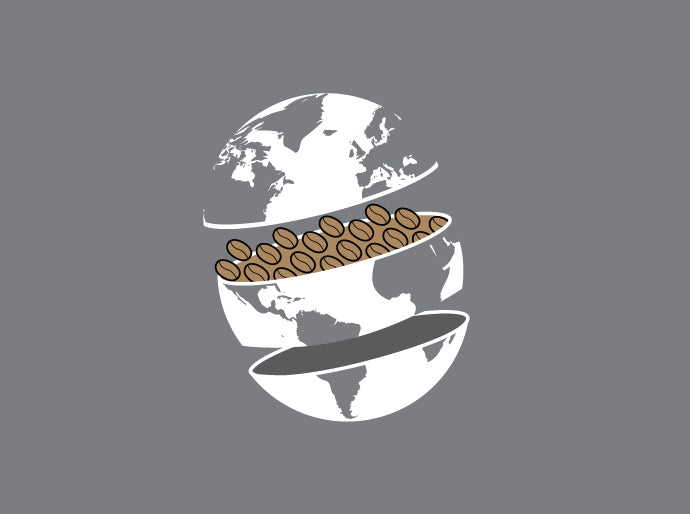ENJOY 15% OFF A NEW SUBSCRIPTION

Coffee Regions: A Quick Guide to Coffee Growing Regions
Today, coffee is a culture and so much more than a morning drink to kick start your day. Coffee connoisseurs relish the opportunity to explore coffees from different regions and to discover the distinctive taste notes specific to each coffee producing region.
To delve deeper into this emerging coffee culture, let’s profile some of the major coffee growing regions and break down the geography of coffee production.
The World’s Coffee Growing Regions
In Halo’s abridged take on the World Atlas of Coffee, an informational guide that takes coffee lovers on a global coffee tour of coffee growing regions, we will explore, explain, and guide readers to enjoying the best coffees from around the world.
The Bean Belt
Globally, there are three primary coffee growing regions – Central and South America, Africa and The Middle East and Southeast Asia. These regions are all located along the equatorial zone between the Tropic of Cancer and the Tropic of Capricorn, widely known as the "Bean Belt". The tropical and subtropical climates found in the “Bean Belt” as well as the abundance of growing regions with elevations of 800-2,200 metres above sea level provide the ideal conditions for growing coffee beans.
The majority of coffees on the global market are grown in the approximately 10 million hectares of farms in the main coffee growing regions within the “Bean Belt”. Despite growing within a similar latitudinal perimeter, coffees grown in these regions have vastly different and distinct regional flavours, hence the coining of the popular phrase, “geography is a flavor”. These distinct flavours are a result of the differences in soil chemistry, weather, sunshine, rainfall, altitude and processing methods.
Central and South America Coffee Regions
At the top of that Bean Belt, is Central America. Most coffee beans in this region come from Guatemala, Nicaragua, El Salvador, Honduras, and Costa Rica.
Costa Rica in particular has superior conditions for growing exceptional coffee with incredibly aromatic flavours. Central America coffee beans as a whole are exceptionally well-balanced, medium-bodied, and mild. They have medium acidity and a clean, bright taste and are enjoyed in almost every specialty coffee shop around the world.
The South America coffee region encompasses Brazil, Colombia, Bolivia, and Ecuador. Colombian coffee is one of the most talked about and popular coffees, but it's Brazil that produces by far the highest coffee volume in the world - a title that the country has held for the past 150 years. Brazil boasts the total production of green coffee and arabica coffee, owing to its perfect climate and superior growing conditions.
Though closely similar in attributes to the Central American coffee, South American coffee is often mild-bodied. It is a bit creamier, gives a clean cup, and often with an appreciable chocolate aftertaste.
Africa and the Middle East Coffee Production
The African coffee region encompasses a handful of countries, namely Kenya, Ethiopia, and Tanzania. Other participating countries include Rwanda, Burundi, and Uganda. This African region produces a unique and complex morning fix with a sweet, fruity, and delicate floral aroma. Most African coffee originates from Kenya on the slopes of Mount Kenya and their beans are often full-bodied and full of spirit-lifting fragrance.
Ethiopia is also a significant producer in the African coffee region, accounting for around 3% of the world coffee market, with approximately 60% of Ethiopia’s foreign income coming from coffee production alone.
“Legend has it that coffee berries were first discovered in Ethiopia by a Shepherd that stopped to examine a coffee bush after noticing his livestock were overly animated.”
Today, Ethiopian coffee is mainly picked from trees in three central regions, namely Sidamo, Harer, and Kaffa, whilst Ethiopian Arabica bean varieties include Longberry, Shortberry, and Mocha.
The largest bean, Longberry is considered superior in quality and flavour. The Shortberry variety, which originates in Eastern Ethiopia are smaller coffee beans as the name suggests, but are still considered a superior grade coffee bean. Shortberry coffee beans have a deliciously spicy full body, spiked with a floral-acidity and fruity blackberry notes. The Mocha coffee bean variety is a highly sought-after commodity, known for the complex and heady spice notes, sharp, juicy citrus and smooth, rich chocolate.
In the Middle East region, Yemen is the major coffee producer. As Yemen’s coffee crops originated from Ethiopia, coffees from this region have very similar attributes and characteristics to Ethiopian coffee beans. Yemen coffee growers dry-process beans which creates a bright, full-bodied and spicy brew that dances on the taste buds.
Southeast Asia
Since the late seventeenth century, Coffee has been grown and consumed in Southeast Asia; particularly famous for Vietnamese and Indonesian coffee beans.
The Indonesian islands of Sulawesi, Java, and Sumatra produce distinct, full-bodied, rich, and earthy beans, commonly used in blends. Beans produced here have clean, smooth characteristics, with a juicy fruit taste and nutty aroma.
Vietnam is the world’s second largest coffee exporter, producing mild, delicate-flavoured, and medium-bodied beans. Several varieties of coffee are grown in Vietnam micro-climates, including Robusta and Arabica explored further in our article here.
It’s not just Indonesia and Vietnam that produces excellent coffee. Sumatra’s reputation for producing coffee cannot be beaten, with its low acidity, earthy and rich dark chocolate tasting beans. Whilst coffee is Laos’ biggest agricultural export, with Southern Laos growing some of the world’s most special Arabica coffee known for its light citrusy, floral notes. Furthermore, Laos grows Robusta coffee at higher altitudes than other countries, producing a very special bean indeed.
Summing Up The World’s Coffee Growing Regions
In this article, we’ve profiled some of the world’s major coffee growing regions, Central America, South America, Africa, The Middle East, and not forgetting Southeast Asia. We’ve also broken down the geography of coffee for you, but now the hard part is to decide which of the world’s best coffees you’ll choose to drink next.
Quote Source: https://medium.com/@darahghanem/how-arabs-introduced-coffee-culture-to-the-world-99d2a4583e37
